Welcome to our newest column: Bike Science with Shawn Small
One of the more frustrating aspects of cycling in an urban environment is not being able to trigger a signal and being stranded at an intersection.
There you are, riding happily along, when you come to a red light and — after an entire signal cycle — you get the sinking feeling that the light is ignoring you. Fortunately, in many cities (including Portland) traffic lights are triggered by the presence of a bicycle. But how does it work? Is there a special technique for getting the green?
To supplement my own understanding of this topic, I got in touch with Peter Koonce, the Division Manager of Signals, Street Lighting, and Intelligent Transportation Systems (ITS) for the City of Portland (learn more about him here).

The word on the street seems to be that the sensors are either weight or magnet based, but Koonce assures me that’s not the case. The truth is, neither weight nor magnets will get you the green; the sensors are actually based upon the principles of electrical inductance. Here’s how it works…
If you ride around Portland, you’ll observe one of following three patterns in the road at each traffic signal;
- Circular loop: basic circle shape
- Quadrupole loop: two squares next to each other
- Diagonal Quadrupole: two diagonal coils
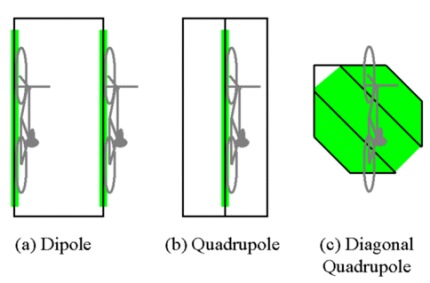
A loop of electrical wire is embedded in these patterns. An electrical current (like your home electricity) runs through these loops at a set frequency and power; this produces an electromagnetic field in the loop of a constant value. When a metal object — like a bicycle wheel — passes over this loop, it disturbs this electromagnetic field. A detector measures this disturbance and sends a message to the traffic signal controller saying that someone is waiting. The most sensitive part of the inductive sensor is marked with a small bike lane icon. By putting your wheels directly on top of this marking you will disturb the electromagnetic field and signal the detector.
According to sensor manufacturers, bicycle rims and cranks generally provide enough metallic material to trigger the sensor. But if you have a full carbon fiber bike, carbon fiber wheels, and carbon fiber components, you could be out of luck.
These sensors may not be set sensitive enough to measure the disruption in the field caused by a bicycle; this can lead to triggering problems and leave you stuck in the road. So if you are at a familiar traffic signal with your bike correctly placed on the sensor and unable to trigger the sensor in a timely manner, contact your local Department of Transportation to report the sensor (if you’re in Portland, call (503) 823-1700).
Loop sensors aren’t perfect, so there are a lot of interesting new systems being developed. One of the more exciting ones uses a digital camera and image recognition software to detect when someone has pulled up to a traffic signal. The City of Portland has one of these on the west end of the Broadway Bridge to activate the bike signal. Personally, I would love to see a small light bulb turn on when you have triggered the sensor to let you know that you are correctly waiting in line.
So save your time and money and don’t bother gluing magnets to your shoes. The easiest way to trigger the traffic sensor is to observe the markings on the road and safely put your wheels on those marks and wait for your turn.
Want to know more?
- City of Portland’s Manual on getting detected.
- Everything you ever wanted to learn about road inductance sensors here, here, and here.
- A patented design to trigger the sensor.
— Hope you enjoyed the first Bike Science column. We’re just getting started so stay tuned for more. If you have a question or a topic you think Mr. Small should tackle, drop us a line and we’ll send it to the lab for analysis.
Bike Science is sponsored by: Strava.com – GPS cycling, virtual competitions and detailed ride analysis.


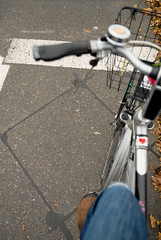
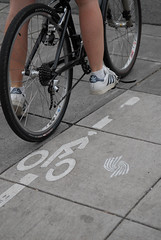


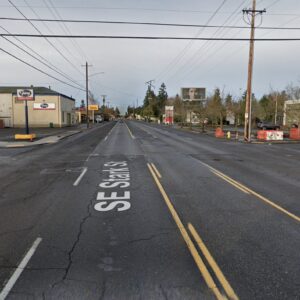
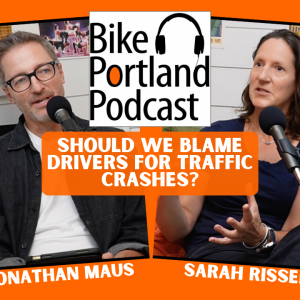
Thanks for reading.
BikePortland has served this community with independent community journalism since 2005. We rely on subscriptions from readers like you to survive. Your financial support is vital in keeping this valuable resource alive and well.
Please subscribe today to strengthen and expand our work.
Great info! Thanks Shawn, I knew this column wouldn’t disappoint.
No more magnets glued on my shoes, okay… but it sounds like chain mail leggings would probably help, right?
Very interesting, thanks! Looking forward to more of these columns!
Thanks for writing about this! I’ve been wondering about this for years. Question–if the bike icon is present, but no obvious lines in the pavement are present, does that mean there is or is not a sensor?
Bottom bracket shell/bearing assembly sits lowest on the bikes frame and is easily a half pound of steel of some sort most of the time…carbon fiber bottom bracket bearings?
Most any aluminum, carbon or titanium bike should have enough steel in this location on the bike to do the trick…
If u have to, lean the bike over the ‘trigger’ wire with the bottom bracket and peddle/crankarm as close to the roadway surface as possible.
More light triggers for bikes!!!
Some bikes use ceramic bearings in the bottom bracket.
Thanks, Shawn. Look forward to more of the practical and cool arcana from the science corner.
Happy riding.
Thanks Shawn. It’s good to keep refreshing this information, as new cyclists join us every day.
Unfortunately, these loops exists at only an abysmal fraction of controlled intersections and the loops only work well a fraction of the time.
For years Portland has been ahead of the curve with examples of neat ideas, but we’ve a long way till the rubber hits the road in an equitable functional way.
Cheers to all the folks who’ve got us so far.
I’d look forward to helping out with action from the BTA or the CCC o AROW or the PeoplesDOT or BikePortland or whomever to help better mobilize city resources so that, since the traffic laws equally apply to people in cars and on bikes, that the traffic engineering spending goes to work in ways that don’t exclusively work for the automobile crowd.
We’ve tooted Portland’s horn long enough.
Time to ring a bell.
Love this column, nice work Shawn!
@ nosilla #4: if there’s a bike icon present, definitely put your bike on it — the sensor loops have been paved over but they still work. That icon is sometimes the only way to know where to wait (the photo is a case in point).
And one more thing to add: stay there until the light turns green! It’s not sufficient to just roll over the sensors. If you leave the sensor loops before the light turns green, the signal might assume you’ve taken a right on red and are no longer waiting…and it won’t turn green for you.
Maybe this question is better suited for a follow-up article, but I would be interested to know what you are allowed to do when you get caught in the intersection and the light won’t change.
So suppose there is a loop or diamond in the road and there is no bike symbol indicating the most sensitive part of the arrangement. Where should a bike be positioned? I’ve heard that for circle loops, it should be far enough from the edge of the loop so your wheels are both touching the edges of the loop. Is that true? what about the diamond-shaped sensors?
Saying that a magnet won’t effect an electro-magnetic field is highly conter-intuitive, and while I’m not an electrical engineer, I think it’s just flat out wrong.
Brian E #11:
I’ve heard that if a signal passes you up for more than two cycles you can proceed through with caution (since you can’t just wait around forever because the signal is telling you to), but I have no idea of the actual legal rules. Perhaps someone who actually knows something about it can comment!
El Biciclero #12:
Just from my personal experience riding around, but I seem to find waiting on the right hand side of the circle loop works pretty well for me. I’ve only not gotten a light once or twice when I’ve been able to spot the loop and stop over it.
I think the sensors should be set so that a car has to wait until a bicycle comes to trigger the light 🙂 Seriously, I’m soo tired of waiting through several light cycles for a break in traffic so I can get across the freaking road, because a dimwit can’t be bothered to adjust the sensitivity of the sensor to pick up my steel bike with aluminum rims. Seriously, they don’t even need an entire bike, just a single rim will work to trigger the sensor if it’s adjusted properly. You think they could find room for a BMX rim (least amount of material of the common bike sizes) on the freaking truck to set the sensor.
And yes, I get a bit peeved about this issue, especially after someone bitches at me about cyclists “always” running red lights.
@Rider #13
Think of it like this: when measuring the vibration in a column of water does changing the color of the water change the period or frequency of the vibrations? All a magnet does is provide a different space for the energy to vibrate, it doesn’t change the vibrations materially. In order to do that it would have to be either very massive in which case it wouldn’t be any different that a bigger bike, or it would have to be long and thin which would make it like a loop of wires, which also causes the sensor to trigger.
re comment 14, to be strictly legal you would have to make a right turn on red, and then — oh, wait, you can’t make a u-turn within city limits, 811.365. okay, what you would need to do is dismount and cross as a pedestrian. ‘course if you hit the pedestrian signal button you should get the light eventually. here and there, the city has put these buttons within reach of a cyclist who has cooperated in pulling to the curb.
is it legal to turn left against red light when it would not trigger my bicycle?
Why bother? The law says if a cop didn’t see ya run da red, ya didn’t do anything wrong. Besides, traffic lights are way over-rated.
There are some valid reasons why runnin’ da red is not that bad of an idea. 1) No or light traffic; 2) No hazards in the immediate area; 3) For sum weird reason, you rollin’ da ‘hood in spandex, on a high-dolla ride, beggin’ to git JACK’d.
h,
in the instance you cited, assuming you’re in a left turning lane, where you’ve got a red, but through traffic hs a green, i would (make sure it was safe to) merge to the rightmost lane, cross to the opposite sidewalk, and then wait for that light to signal for you to go straight.
if you’re in a non-turning lane left lane, and so the light is red for through traffic, then i would recommend the same, except of course you’d have to press the pedestrian signal first to get the red light to change.
My friends and I used to use a trombone to trip a signal in order to open one-way only gates into restricted parking lots. That way you could drive in the “out only” gate and bypass the “pay to get in” gate. The trombone is brass, so it would set off the trigger.
#4 nosilla – If you can’t see the lines (saw cuts) in the pavement it is likely that we put the detector in before the asphalt was in position. That’s preferred practice if the entire street is being rebuilt and results in the detection lasting a lot longer than it will otherwise.
#8 Mike – we are looking forward to your phone calls. We’ll respond pretty quickly if you call in and give a good description of what intersection (in Portland) you are at and what direction you’re headed.
#12 El Bicerco – you need to be where you break the symmetry of the electrical field. In the middle of the sensor is not the best. Our stencils are on the edge of the circle. One more note: if you see diamond loops, those are more than likely pretty old.
#13 rider – the magnet can cause problems with the detector.
#16 Opus the Poet – we have a guy in the truck with a bike tire, honestly.
#19 Paul Tay – disregarding traffic signals is one of the things the general public responds to with the most negativity. In Portland, we’re ready to do better than we have.
Last point for those of you in Beaverton (where video detection cameras are their standard)… they can detect people in bicycle lanes are usually set up to do so. The cameras are detecting changes in pixels. Our installation on the west end of the Broadway Bridge has trouble with people on bicycles at night wearing all black without headlights. If you’re not lit, get lit (as the saying goes). A stronger light is better.
You have to be lucky to get these sensors to register, even when you do know how they work. The truth is they are made for cars, which is fine. If I want to stop at a light and fiddle around, I’d drive a car. Luckily with a bicycle there is much more freedom.
A light not triggered by a sensor is malfunctioning. A malfunctioning light should be treated as a stop sign. No need to hang out for multiple cycles and be a target in the middle of the road.
I’m so happy to see this article!
I’ve noticed a lot of red-light running by cyclists lately on my bike commute home through the rose quarter and up to Vancouver-Williams.
Often, the cyclist at the front of the bike lane pulls up to the light, but doesn’t know to line their bike up on the loop detector. Then twenty other cyclists pull up behind the first cyclist, all waiting for their light. The light never comes, because the cyclist at the front is not lined up to trigger the light. So twenty cyclists all just decide to run the red.
I really think we could use huge “LINE BIKE UP HERE” words with an arrow, next to key loop detectors at intersections of potential danger or conflict.
Not many people out there are traffic engineers, and would most likely kill themselves if they knew something as dorky as what loop detector was!
Nick (#2) – Magnets on the shoes will still work. Moving a wire through a magnetic field is one of the most common ways to create inductance, it’s the basic principle behind all electric motors and generators.
Jonathan, not all metals will work – only those which are ferromagnetic. Those that are less ferromagnetic will have a lesser effect, possibly below the threshold of the sensor.
rider (#13) – You are correct. A magnet will affect (and effect) a magnetic field.
General comment – This is exactly why these types of sensors should be removed. So-called “intelligent” traffic signals are meant to optimize intersection throughput. They inherently prioritize cars over other modes. push-activated walk signals for pedestrians are even worse. The pendulum has swung too far, convenience is costing us livibility. The best way to restore livibility and modal equity is to go back to timed signals. Also, timed signals are more reliable as there are fewer wearable parts. I expect there are many who will disagree (not a few of them are likely traffic engineers)
#22, Peter, the general motoring public responds negatively to anything “impeding” their intentions of criminally speeding just to catch the red.
“Much of what has gone on in highway design and operation practice has represented activity without sufficient thought.” Highway Safety, Design and Operation. Report 93-7. Subcommittee on Investigations and Review. Committee on Public Works, U.S. House of Representatives, July 1973.
“The fallacy has been to cram ‘good medicine’ down people’s throat because the ’experts’ thought it was good for them.” Fisher, E. G., and R. Reeder. Vehicle Traffic Law. Traffic Institute, Northwestern University, Evanston, IL, 1974, 20, 29.
“Advertised as a panacea for all traffic ills in its early days, the traffic signal turned out to be one of those medicines that cures one disease and gives you another. It has been known since the late 1920s that signals reduce right-angle accidents at the cost of causing more rear-end and left-turn collisions.” Manual on Uniform Traffic Control Devices. BPR & AASHO, 1935, 63.
I think this column is a great start, and I appreciate (I think we all did despite our sloppy use of language) that it’s electrical induction rather than magnetism…
BUT what about aluminum (Thanks matt picio) – the material of choice fo rthe overwhelming majority of rims?
Shawn says “metal object” in the explaination, referrng to a wheel; I need this fleshed out a little.
I rarely have an issue getting the loops to read me. Thanks Peter and PDOT for keeping them working for us!
Much of my commute is in unincorporated Washington County, north of Hwy 26. I don’t think I know of a single signal (where I am not going the direction that the intersection defaults to) where I can actually get one of these to trigger with even my steel touring bike. Most of the ones I have trouble with are in left turn lanes, but sometimes it’s just in the straight travel lane.
Some of them are loop sensors, and others are the camera sensors – both seem to have problems.
So, who can I contact about these in particular? Who do I contact at Washington County?
hemp22, I feel your pain. It just so happens that Wash. Co. just released a new website/form where you can request various road and transpo services…
http://www.co.washington.or.us/LUT/Divisions/Operations/request-service.cfm
if you use it, report back and let us know how it goes.
@Matt #26 and JAT in Seattle #28
The basic physics of electromagnetic induction require a magnetic field, a conductor, and relative motion between the two. In the case of the sensor loops, the “motion” is supplied by the growing and collapsing of the magnetic field as the alternating electrical current in the loop regularly reverses direction. The conductor (your bike wheel or crankset) that you put into the field need not be ferrous – note that electrical transformers are wound with copper wire, for example. The magnetic coupling can be improved with ferrous material – those same transformers are often wound around an iron core. I have worked extensively with inductive proximity sensors on machinery – just a different packaging of the same concept – and I can assure you that a properly adjusted sensor does a dandy job of detecting aluminum within its sensing range. The requirement is that the object being sensed be conductive and thus able to develop its own magnetic field that will counter the field of the sensor and thus be detectable.
Has anybody with clipless pedals tried out putting their shoe cleat on the sensor stencil? Just curious if that is enough metal to get a result.
My experience is that local municipalities like Portland and Beaverton have done a great job of tuning their vehicle detectors to pick up bicycles.
I rarely have trouble getting a vehicle detector to pick up my bike — as long as it’s not an ODOT facility!
If it’s a state highway (which can be an arterial like 82nd or Powell that just happens to be posted with a state highway number), then it’s ODOT’s jurisdiction and it’s a crapshoot at best.
Most of the various intersections where I might cross Scholls Ferry (a state highway), for example, fail to detect bicycles, even when stopped over the most sensitive part of the detector.
Just another example where ODOT still needs some help “getting it”.
@buglas #31
i have the mtb shoes on today and will investigate it tonight on my journey home
trial 1) control to figure out pattern
trial 2) aluminum 29’er
trial 3) human with mtb cleats (no bike)
any other suggestions?
buglas #31:
I ride clipless with speedplay zero cleats, which are a large in terms of cleat size. I always try to stop with my bike on the right side of the loop. I clip out with my left foot 99% of the time, so that would have me put my cleat down somewhere inside of the loop.
I am not sure if the amount of metal in my cleat makes a difference or not. I ride an aluminum/carbon bike with aluminum rims. But like I said earlier, I rarely have problems tripping sensors.
I haven’t ridden my steel bike with flat pedals enough this summer to make any comparisons at intersections that I frequent vs. the bike I normally ride.
#26 matt picio – the issue of sensors is one point of debate. The transportation engineering community has treated pedestrians and people on bicycles poorly because the old way of doing things was to focus on vehicle throughput. Policies in Portland are much different today, where we are governed less by the Highway Capacity Manual, than by the Climate Action Plan, more emphasis from Jane Jacobs than Robert Moses.
#27 Paul Tay – see above. Interesting Quotes from a historical context. In my previous life as a consultant, that’s still the norm across the industry, yet things look different in Oregon and especially in Portland.
#33 GlowBoy – Most of the ODOT signals within the City of Portland are operated by PBOT. Let us know if you’re having trouble at Powell or 82nd Ave.
The problem isn’t the detectors, but the way we use them and how we coordinate the signals with adjacent intersections. If we’re trying to maintain traffic flow on the major street (old highway), then you can expect some delays. If you’re seeing that a lot, call it in. It’s the same thing with the pedestrian push buttons at signals.
buglas (#31) – That’s exactly why a ferromagnetic metal is needed, because rubber tires insulate the bike (and cars) from ground and prevent the bike from being a conductor. In the case of cars, there are plenty of magnetic fields being generated which would affect the loop, like the alternator.
Peter (#36) – So far, I haven’t seen much evidence indicating that throughput is not still the primary goal of most of Oregon’s transportation departments. Portland is the shining exception, but I think that even PBOT would balk a bit at going back to timed lights, or to removing the requirement to push a button to get a “walk” signal.
#32 – Jonathan (re Washington County Operations web site request form) – I used this form to report an issue (not a traffic signal issue) when they recently repaved Bull Mountain road; I received a helpful response within a week.
My limited experience is that relatively few intersections have the bike sensor symbols. And stopping on one side of the circular sensors and leaning the bike over has been relatively ineffective. I cross SE 82nd eastbound at Boise five nights a week and return westbound five mornings. There is a symbol heading east but none heading west. Also, the light stays green for a very short time, barely allowing me to cross the center line before going yellow.
This push a button thing to be able to cross a street was new to me when I moved to Portland after having lived in big east coast cities, where peds always get the signals and cars can’t turn right on red. I’m not sure why these rules aren’t in effect here, especially in the denser pedestrian areas.
Some lights only change for cars no matter where you place your bike. Plus, they favor the busier street’s traffic and will NOT change without a car. Ever. Annoying, especially for compulsive rule-followers. Nothing like sitting an an intersection interminably at 0500 feeling like a dufus.
Surely, no conscientious cyclist would ever run a red light, especially at a place like SE 82nd Ave., when no car is visible in either direction from Holgate to Powell. No one would ever do that.
@Matt #31 – Here’s a somewhat techie discussion of sensor loops with respect to bicycles. There is some discussion under Theory of Operation that addresses aluminum rims. Apparently steel rims can actually be harder to detect than aluminum ones.
Oops! Fumbled that last link.
Once more, in plain text:
http://www.humantransport.org/bicycledriving/library/signals/detection.htm
In Beaverton, I get a mixed bag with signals. Some trip and some don’t. There’s one in particular close to where I work that is seductively marked with a bicycle signal that doesn’t work for me (Millikan Way and Murray). I am going to try the Wa Co request service form and see what happens.
That’s the understanding I get from Mr. Science (with all due respect) – Look for the little painted bike icon and sit on it and hope? Gee, thanks! 🙂
See, guys – what did I tell you about the general audience?
Helmets! Do they work?
Peter (#36), thanks for the clarification on ODOT vs PBOT maintenance of state highways in the city. I actually haven’t had any problems on Powell or 82nd, just used those as examples of state highways in the city limits. At least off the top of my head, I can’t think of any intersections within the Portland city limits where I have problems.
I do have problems with Scholls Ferry (OR 210) — at Raab (though I haven’t tried this one lately), and at Laurelwood/Nicol (both directions, and tried recently). That last one is particularly frustrating because I ride it regularly and traffic is often low so I’m often waiting alone at the light — or, worse, a car pulls up behind me but is too far back to trip the detector. Also, Canyon Rd (OR 8) at Canyon Lane never works for me either even though it’s a major bike route.
Jeff (#46) thanks for volunteering to request a fix at Murray/Millikan. I should have done that myself by now if I hadn’t been so lazy. I’ve never gotten that one to work either (eastbound), and it’s irked me for a long time because as you mentioned it has the bicycle symbol painted on it.
In fairness to Beaverton, that’s the only intersection I regularly use out there where I have any difficulty. Lots of other intersections that are minor for most cars but major for bikes — Park and Cedar Hills, Western and 5th, Jenkins and Hocken, to name a few — almost always detect flawlessly for me, even in the left turn lane.
No need to experiment with taping magnets on your shoes etc. in search of a solution. It was already solved several years ago, by a Portland inventor, Scott Kauffman.
See:
http://www.greenlightstuff.com/
This inexpensive device, called Green Light Trigger, was originally aimed at motorcycle riders, but is small enough to attach to a bicycle too.
Maybe Scott will send you a post explaining why it works.
buglas (#43) – Ah, thanks for the link, now I understand. This explains a lot – far more than the original article, and why some ferromagnetic metals *do* work better (nothing to due with the ferromagnetic properties, but with conductivity). And now I understand my mistake with thinking that a ground was required.
Maybe some answers to your questions:
If you see a bike symbol but no cut lines for the loop, the loop is probably under the top layer of asphalt, or is cast into the concrete surface. The detector loop is there, just can’t be seen. Often the cut lines are covered by chip seal or slurry seal surface treatments. Look carefully for the shape of the cut lines as they may still be visible.
On circle loops, place your wheels so that they bisect the circle loop at two points on the loop for best detection. This is easiest to do on the right or left side of the circle.
For loops that don’t detect bicycles, the sensitivity of the equipment can be adjusted. They often don’t make them more sensitive because they will detect passing traffic in the oncoming adjacent lane. Or at least that’s what the traffic signal technicians will tell you. Report these detector loops to the appropriate traffic department after you encounter them. Most agencies have a method of reporting listed on their web site.